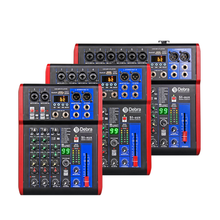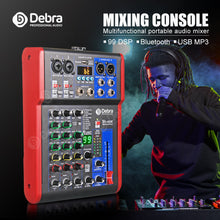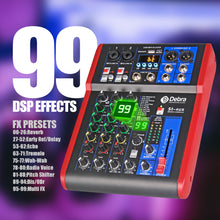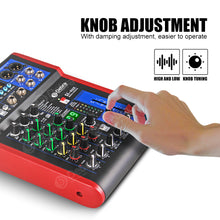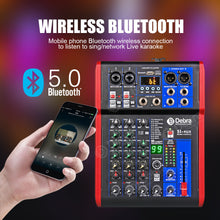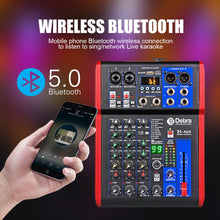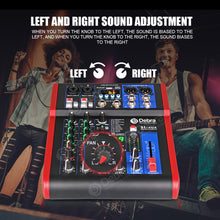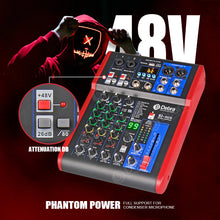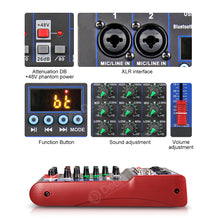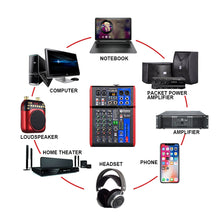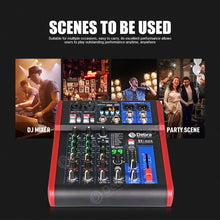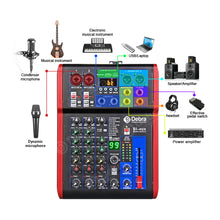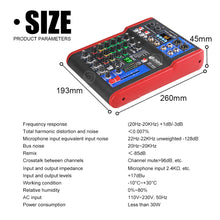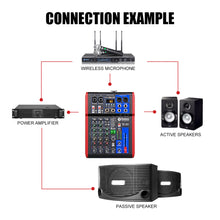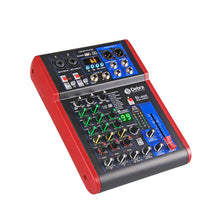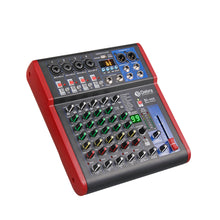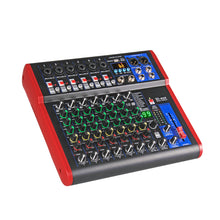
RECORD AND CONNECT TO PC With 99 DSP Effect: This personal mixer has a USB soundcard and audio interface to record and connect to MAC or PC and it has universal digital audio file compatibility. Can be used by beginners or studio professional applications. 99 DSP Effect, can meet most of the scene recording requirements
- BLUETOOTH: This portable 4-channel DJ sound controller has Bluetooth for wireless streaming and use it as an input to mix signal with other input channels. It works with iPhone, Android, iPad, Tablet and MP3 Player. The wireless range is 15 ft
- LED INDICATOR LIGHTS: The recording mixer has LED indicator lights and rotary adjustment knobs for user convenience. It has input selection, master volume controls, independent channel balance and high, plus, low frequency adjustment. Suitable for various recordings of individuals, bands and professionals
- +48V PHANTOM POWER: For reliable power source, this DJ mixer comes with a +48V Phantom power supply. Includes a 3=pin power adapter cable and the stereo output level meter is 12-Segment (-30, -20, -10, -7, -4, -2, 0, +2, +4, +7, +10, CLIP)
U disk output file format: MP3, sampling rate 44.1KHz, bit rate 128kbps
Features:
(1) Microphone/line inputs, stereo line input
(2) Phase, level and overload indication
(3) 1 auxiliary send
(4) MP3, sound card, USB input/output for playback recording
(5) Low average filter (80HZ)
(6) 99 DSP scene effects
(7) Single channel PAD switch (26db)
Parameter:
(1) Equalizer: HIGH +/- 15db @ 12KHZ
MID +/- 15db @ 2.5KHZ
LOW +/- 15db @ 80KHZ
(2) Input impedance: MIC3.8KΩ, other inputs: ≥10KΩ
(3) Output impedance: 120 non-parallel, 240Ω parallel, 22Ω headphones
(4) Frequency response: 20HZ-30KHZ + 0 / -1db
(5) Distortion: <0.01%
The 99 DSP Scene Effects:
0-2: Simulate the reverb of a small space concert hall
3-5: Simulate the reverb of a medium-sized concert hall
6-8: Simulate the reverb of a large space concert hall
9: Auditorium acoustic environment reverb
10-12: Simulate the reverb of the acoustic environment of a small space (room)
13-15: Simulate the reverb of the acoustic environment of a medium-sized space (room)
16-18: Simulate the reverb of the acoustic environment of a large space (room)
19: Small auditorium acoustic reverb
20-26: Analog metal reverb unit produces more pronounced reverb
27-29: Spring water effect
30-35: This effect cuts off the tail sound of the reverb to produce a stronger
36-39: Different delay times form a multi-layer reverb effect
40-43: Separate early reflections and reverb to produce more "brighter" than reverb
44-47: Atmosphere effect
48: Stadium effect
49: Atmosphere effect FX
50-58: Increase the delay signal to form feedback
59: Echo effect
60-65: Add multiple layers of delay to create heavy, multi-layered sound effects
70-73: Change the signal cyclically, modulate the sound
74-79: Tone frequency shift effect
80-81: Chorus effect + reverb
82-83: Edge surround + reverb
84-85: Phase effect + reverb
86-87: Tone frequency shift + reverb
88-89: Delay effect + reverb
90: Delay effect + noise effect
91: Delay effect + reverse sound effect
92-93: Delay effect + and sound effect
94-95: Delay effect + edge surround
96-98: Delay effect + phase sound effect
99: Delay effect + tone frequency shift sound effect



















